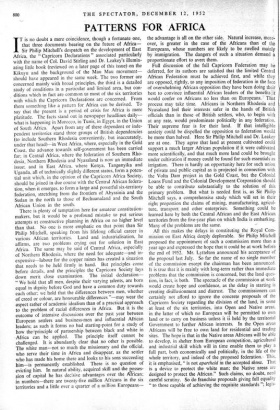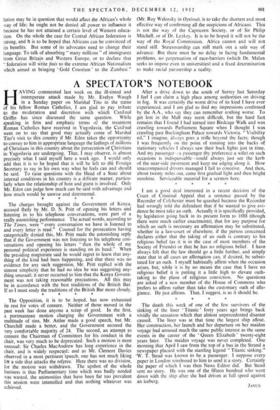PATTERNS FOR AFRICA
IT is no doubt a mere coincidence, though a fortunate one, that three documents bearing on the future of Africa— Sir Philip Mitchell's despatch on the development of East Africa, the " Capricorn Declarations " associated particularly with the name of Col. David Stirling and Dr. Leakey's illumin- ating little book (reviewed on a later page of this issue) on the Kikuyu and the background of the Mau Mau movement— should have appeared in the same week. The two former are concerned mainly with broad principles, the third is a detailed study of conditions in a particular and limited area, but con- ditions which in fact are common to most of the six territories , with which the Capricorn Declarations are concerned. From them something like a pattern for Africa can be derived. To say that the present is a period of crisis for Africa is mere platitude. The facts stand out in newspaper headlines daily— what is happening in Morocco, in Tunis, in Egypt, in the Union of South Africa. Apart from any of these dependent or inde- pendent territories stand three groups of British dependencies (to include Southern Rhodesia conveniently, but inaccurately, under that head)—in West Africa, where, especially in the Gold Coast, the advance towards self-government has been carried far; in Central Africa, where the federation of Southern Rho- desia, Northern Rhodesia and Nyasaland is now an immediate issue; and in East Africa, where Kenya, Tanganyika and Uganda, all of technically slightly different status, form a poten- tial unit which, in the opinion of the Capricorn Africa Society, should be joined in due course with the Central African federa- tion, when it emerges, to form a large and powerful six-territory federation, stretching from the frontiers of Abyssinia and the Sudan in the north to those of Bechuanaland and the South African Union in the south.
There is plenty of temptation here for amateur constitution- makers, but it would be a profound mistake to put serious attempts at constructive planning in Africa on no higher level than that. No one is more emphatic on that point than Sir Philip Mitchell, speaking from his lifelong official career in various African territories. Land and industrialisation, he affirms, are two problems crying out for solution in East Africa. The same may be said of Central Africa, especially of Northern Rhodesia, where the need for adequate—and in- expensive—labour for the copper mines has created a situation that needs to be Meld firmly in hand. But principles come before details, and the principles the Capricorn Society lays down merit close examination. The initial declaration- " We hold that all men, despite their varying talents, are born equal in dignity before God and have a common duty towards each other; we hold that the differences between men, whether of creed or colour, are honourable differences "—may wear the aspect rather of academic idealism than of a practical approach to the problem of racial differences in Africa. But it is the outcome of intensive discussions over the past year between European settlers and business-men and influential African leaders; as such it forms no bad starting-point for a study of how thesprinciple of partnership between black and white in • Africa can be applied. The principle itself cannot be challenged. It is abundantly clear that no other is possible. The white man—not so much the missionary and the official, who serve their time in Africa and disappear, as the settler who has made his home there and looks to his sons succeeding him—is permanently established. There is no question of evicting him. In natural ability, acquired skill and the posses- sion of capital he has decisive advantages over the Rican; in numbers—there are twenty-five million Africans in the six territories and a little over a quarter of a million Europeans— the advantage is all on the other side. Natural increase, more- over, is greater in the case of the Africans than of the Europeans, whose numbers are likely to be swelled mainly by immigration. The dangers of such a situation demand a proportionate effort to avert them.
Full discussion of the full Capricorn Federation may be deferred, for its authors are satisfied that the limited Central African Federation must be achieved first, and while they are opposed, rightly, to any imposition of federation in the face of overwhelming African opposition they have been doing their best to convince influential African leaders of the benefits it would confer on Africans no less than on Europeans. That process may take time. Africans in Northern Rhodesia and NyaSaland feel their interests safer in the hands of British officials than in those of British settlers, who, to begin with at any rate, would predominate politically in any federation. Their supreme fear is for their land. If that intelligible anxiety could be dispelled the opposition to federation would be more than halved. Here Sir Philip Mitchell and Dr. Leakey are at one. They agree that land at present cultivated could support a much larger African population if it were cultivated more scientifically, and that much more land could be brought under cultivation if money could be found for such essentials as irrigation. There is hardly an opportunity here for such union of private and public capital as is projected in connection with the Volta Dam project in the Gold Coast, but the Colonial Loans Fund and the Colonial Development Corporation should be able to contribute substantially to the solution of this primary problem. But what is needed first is, as Sir Philip Mitchell says, a comprehensive study which will set in their right proportion the claims of mining, manufacturing, agricul- ture, transport and other enterprises. Something could be learned here by both the Central African and the East African territories from the five-year plan on which India is embarking. Many of the problems are the same.
All this makes the delays in constituting the Royal Com- mission on East Africa deeply deplorable. Sir Philip Mitchell proposed the appointment of such a commission more than a year ago and expressed the hope that it could be at work befofe the end of 1952. Mr. Lyttelton announced his acceptance of the proposal last July. So far the name of no single member of the commission except the chairman has been announced. It is true that it is mainly with long-term rather than immediate problems that the commission is concerned, but the land ques- tion, in fact, is both. The spectacle of the commission at work would create hope and confidence, as the delay in starting is creating disillusionment and distrust. The commissioners can certainly not afford to ignore the concrete proposals of the Capricorn Society regarding the division of the land, in some . at least of the six territories, into Open and Native areas, in the latter of which no European will be permitted to own land or to carry on business unless it is held by the territorial Government to further African interests. In the Open areas Africans will be free to own land •for residential and trading sites. The hope is that in the Native areas Africans will be able to develop, in shelter from European competition, agricultural and industrial skill which will in time enable them to play a full part, both economically and politically, in the life of the whole territory, and indeed of the proposed federation.- This, it is emphasised, " is not apartheid in the accepted sense. That is a device to protect the white man; the Native areas are designed to protect the African." Such claims, no doubt, need careful scrutiny. So do franchise proposals giving full equality " to those capable of achieving the requisite standards "; legis- lation may be in question that would affect the African's whole way of life; he ought not be denied all power to influence it because he has not attained a certain level of Western educa- tion. On the whole the case for Central African federation is strong, and tt is to be hoped that Africans can be convinced of its benefits. But some of its advocates need to change their language. To talk of absorbing " many millions " of immigrants from Great Britain and Western Europe, or to declare that " federation will write finis to the extreme African Nationalism which aimed at bringing ' Gold Coastism ' to the Zambesi " (Mr. Roy Welensky in Optima), is to take the shortest and most effective way of confirming all the suspicions of Africans. This is not the way of the Capricorn Society, or of Sir Philip Mitchell, or of Dr. Leakey. It is to be hoped it will not be the way of the Royal Commission. Africa cannot and will not stand still. Statesmanship can still mark out a safe way of advance. But there must be no delay in facing fundamental problems, no perpetuation of race-barriers (which Dr. Malan seeks to impose even in universities) and a fixed determination to make racial partnership a reality.



































 Previous page
Previous page